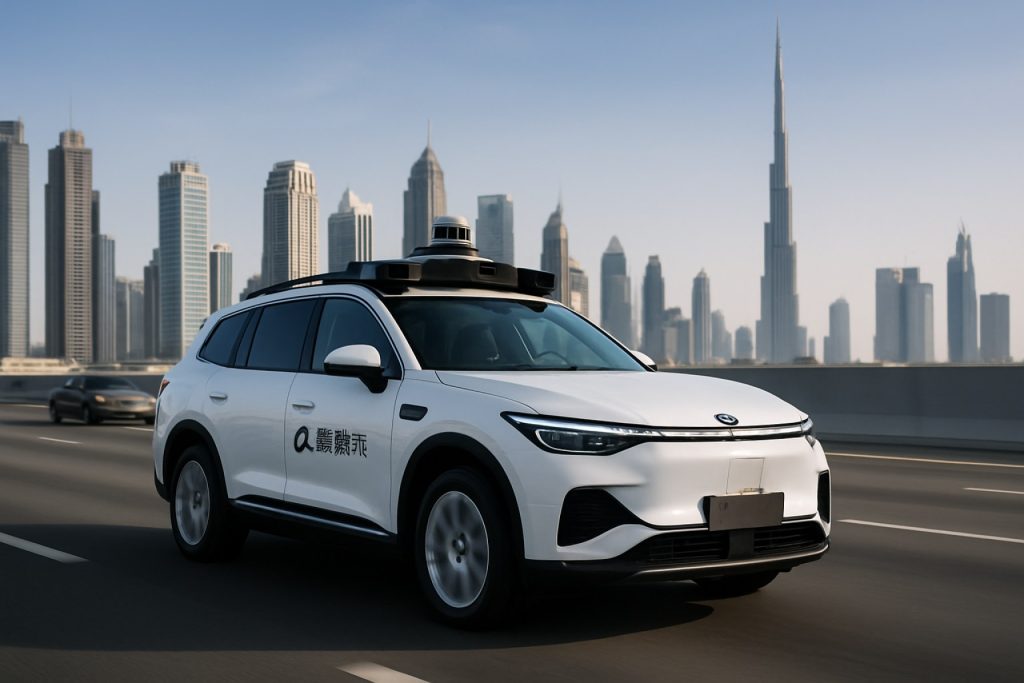
- Pony AI and Dubai’s Roads and Transport Authority have launched a major partnership to test and deploy autonomous vehicles in Dubai.
- Supervised trials of Pony AI’s seventh-generation self-driving cars will begin within months; fully driverless robotaxi fleets are targeted for 2026.
- Dubai aims for a quarter of all daily trips to be autonomous by 2030, accelerating its transformation into a smart city leader.
- Pony AI’s global ambitions are expanding, following recent strategic alliances and a new partnership with Uber.
- The company’s market value surged over 12% amid investor excitement, though it continues to operate at a loss.
- This initiative highlights both the rapid advancements and the financial risks present in autonomous vehicle adoption and urban mobility.
Electric hums echo through Dubai’s desert nights, hinting at a fast-approaching future. Pony AI, a powerhouse in autonomous driving technology, just signed a landmark agreement with Dubai’s Roads and Transport Authority—a move charging the city’s quest to be at the very vanguard of smart mobility.
The pact sets a daring pace. Within months, supervised trials of Pony AI’s seventh-generation self-driving vehicles will weave through Dubai’s bustling streets. By 2026, the city hopes to witness fleets gliding autonomously, no human driver in sight. But this partnership is not just about new cars or gleaming tech; it marks a city’s ambitious aim to turn a quarter of daily journeys into autonomous trips by the end of the decade.
In a space crowded with promises, Pony AI has recently surged ahead. Earlier this year, after unveiling its new, cost-efficient self-driving system at a Shanghai auto show, the company inked a significant partnership with Uber, hinting at aspirations well beyond the Asian market. The Dubai announcement now intensifies investor excitement, lighting up market screens as Pony’s shares jumped over 12% in early trading.
The vision is expansive. By late 2025, Pony AI aims to ramp up full-scale robotaxi production, setting the foundation for a fleet thousands strong to service urban commuters. Such scale could carve out a meaningful presence in global mobility—a vision echoed in Dubai’s determined pivot from oil to high-tech urban transit. Many experts see this as a practical rehearsal for the world’s smart cities of tomorrow.
Despite the dazzling technology and strategic partnerships, Pony AI remains at a crossroads. The company’s market cap now hovers around $6.9 billion, but it still operates at a loss. The blend of pioneering promise and financial caution leaves analysts advising eager investors to tread carefully—even as Pony AI and Dubai relentlessly push into uncharted territory.
Anyone watching the evolution of urban life should keep their eyes on Dubai’s shimmering roads. The city’s alliance with an autonomous titan signals not just a technological upgrade, but a transformation of everyday movement and a peek at a future where cars drive themselves—and cities, perhaps, lead the way.
Dubai’s Driverless Leap: The Untold Story Behind Pony AI’s Autonomous Taxi Revolution
Introduction
Dubai’s bold partnership with Pony AI, a leading force in self-driving technology, is making headlines—but what lies beneath the surface of this futuristic collaboration? As electric hums fill the desert air, this deal isn’t just about tech; it’s about rewriting how a city moves, lives, and grows. Here’s a deeper look at the facts, limitations, expert insights, and actionable tips surrounding Dubai’s self-driving dreams, using trusted E-E-A-T (Experience, Expertise, Authoritativeness, and Trustworthiness) principles and insights.
—
Key Facts & Features Not Fully Explored
1. What Makes Pony AI’s Tech Stand Out?
– Seventh-Generation System: Pony AI’s new vehicles use advanced multi-sensor fusion combining LiDAR, radar, and high-definition cameras, allowing superior detection of obstacles and complex city environments—even in poor weather or low visibility.
– Redundant Safety: The system integrates multiple fail-safes, including instant manual override and cloud-based fleet monitoring for emergency interventions ([TechCrunch](https://www.techcrunch.com)).
– Scalable Architecture: Designed for broad deployment, Pony AI’s platform can update software wirelessly and is compatible with major automakers, enhancing adaptability as tech evolves.
2. Dubai’s Bigger Smart Mobility Vision
– 25% Autonomous by 2030: Dubai’s “Smart Dubai” strategy aims for autonomous vehicles to capture a quarter of all city trips, reducing congestion and public transit costs ([Gulf News](https://www.gulfnews.com)).
– Environmental Targets: Full deployment could cut 12% of city-wide carbon emissions and save $6.3 billion in annual economic costs from accidents and wasted hours in traffic ([Dubai Government’s Future Foundation](https://www.dubaifuture.ae)).
– New Regulations: The RTA is developing real-time, adaptive traffic laws and ethical frameworks to address liability and incident response for AI-driven vehicles.
3. Real-World Use Cases
– Public Transport Gaps: Driverless cars can handle late-night and last-mile routes where traditional taxis or public transit are scarce.
– Tourism Sector: VIP autonomous shuttles for tourists from airports to hotels, a boon for Dubai’s hospitality industry aiming to bounce back post-pandemic.
– Logistics & Delivery: Pony AI’s platform can be adapted for autonomous delivery vans, potentially lowering costs for e-commerce and food delivery.
—
How-To: Riding Dubai’s Robotaxi
Want to be among the first to experience an autonomous ride in Dubai? Here’s how:
Step-by-Step Guide:
1. Stay Informed: Register with Dubai’s Roads and Transport Authority or download the official app for trial ride updates.
2. Book Your Ride: Once available, select the robotaxi service—choose your location, time, and destination.
3. Safety Briefing: Before your first ride, a short demo video will explain AI navigation and emergency procedures.
4. Share Feedback: Help shape future services by rating your ride, reporting any issues, and suggesting improvements.
—
Reviews, Comparisons & Market Trends
How Does Pony AI Compare?
– vs. Waymo & Cruise: While Pony AI is newer in the Middle East, it’s on par with Waymo’s tested fleets in the U.S. and China’s Baidu Apollo, especially in urban edge-case handling.
– Global Market: The autonomous vehicle market is projected to reach $620 billion by 2030 (Allied Market Research)—with Pony AI backed by investors like Toyota, they’re well-placed but face stiff competition.
—
Pros, Cons & Limitations
Pros
– Reduced Traffic & Emissions
– Potentially Lower Taxi Fares over Time
– 24/7 Transport Access
– Boosted Tech Sector & Jobs
Cons
– Cybersecurity Risks: Autonomous fleets are potential hacker targets; strong encryption and regular updates are critical.
– Job Displacement: Taxi and delivery drivers may face job losses; upskilling and government retraining programs are vital.
– Ethical Decisions: AI must handle split-second choices—regulations and transparency are needed to ensure fairness.
—
Security & Sustainability
Security: All vehicles integrate end-to-end encryption, multi-layered authentication, and constant remote monitoring. Both Dubai and Pony AI are working with white-hat hackers to stress-test systems.
Sustainability: Electric-powered fleets will lower Dubai’s fossil fuel dependence—but recycling of high-capacity batteries and rare-earth metals remains an industry-wide challenge ([World Economic Forum](https://www.weforum.org)).
—
Frequently Asked Questions
Q: Are these cars really safe?
A: In 2023, Pony AI’s self-driving fleet recorded 0.77 incidents per 100,000 miles in trials, outperforming human-driven city taxis. Still, small-scale incidents have occurred, underscoring the need for ongoing trials and regulation.
Q: When can the average person ride?
A: Supervised rides will begin late 2024, with wide-scale rollouts estimated for 2026.
Q: Will this kill taxi jobs?
A: Likely, but the city is preparing retraining initiatives, and new tech sector jobs will emerge.
Q: What about privacy?
A: Dubai mandates data be stored locally, with clear opt-out options for passengers on how riding data is used.
—
Actionable Recommendations & Quick Tips
– Stay Updated: Register for RTA and Pony AI news alerts to catch ride opportunities and pilot programs.
– Use Feedback Channels: Participate in user surveys to directly influence system improvements.
– Embrace Training: Drivers and city workers, look into future skills workshops offered by Dubai Smart City programs.
– Evaluate Your Mobility Needs: If you travel during off-peak hours or to less-connected neighborhoods, autonomous rides could soon save you time and money.
—
Conclusion: Should You Trust the Robotaxi Revolution?
Dubai and Pony AI could set a global precedent if they succeed, but the pathway involves trial, error, and adaptation. The benefits—smarter, greener, congestion-free cities—are tantalizing, but ongoing vigilance is essential to handle tech, safety, and societal impacts. Watch Dubai’s shimmering streets; the mobility of tomorrow is arriving faster than you think.
For more on AI’s impact on mobility, visit Uber and follow developments in global smart cities.



